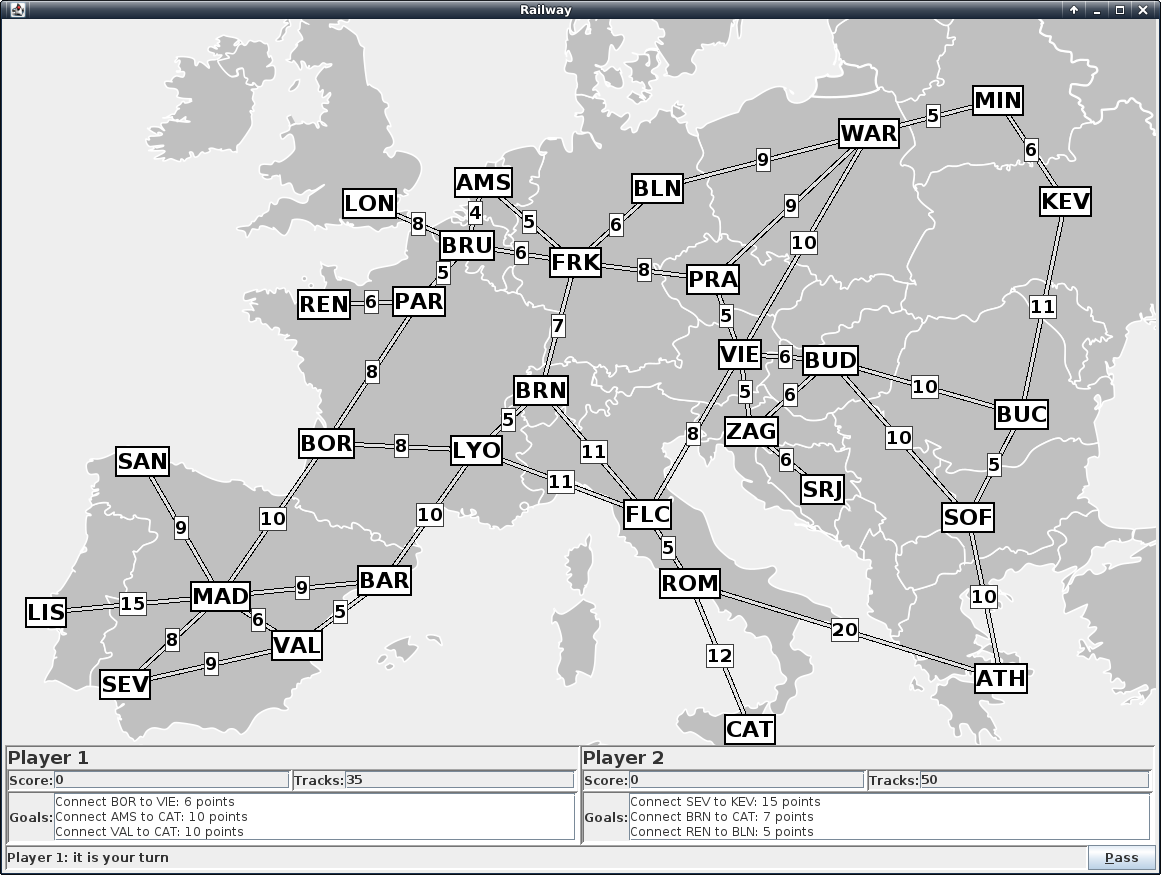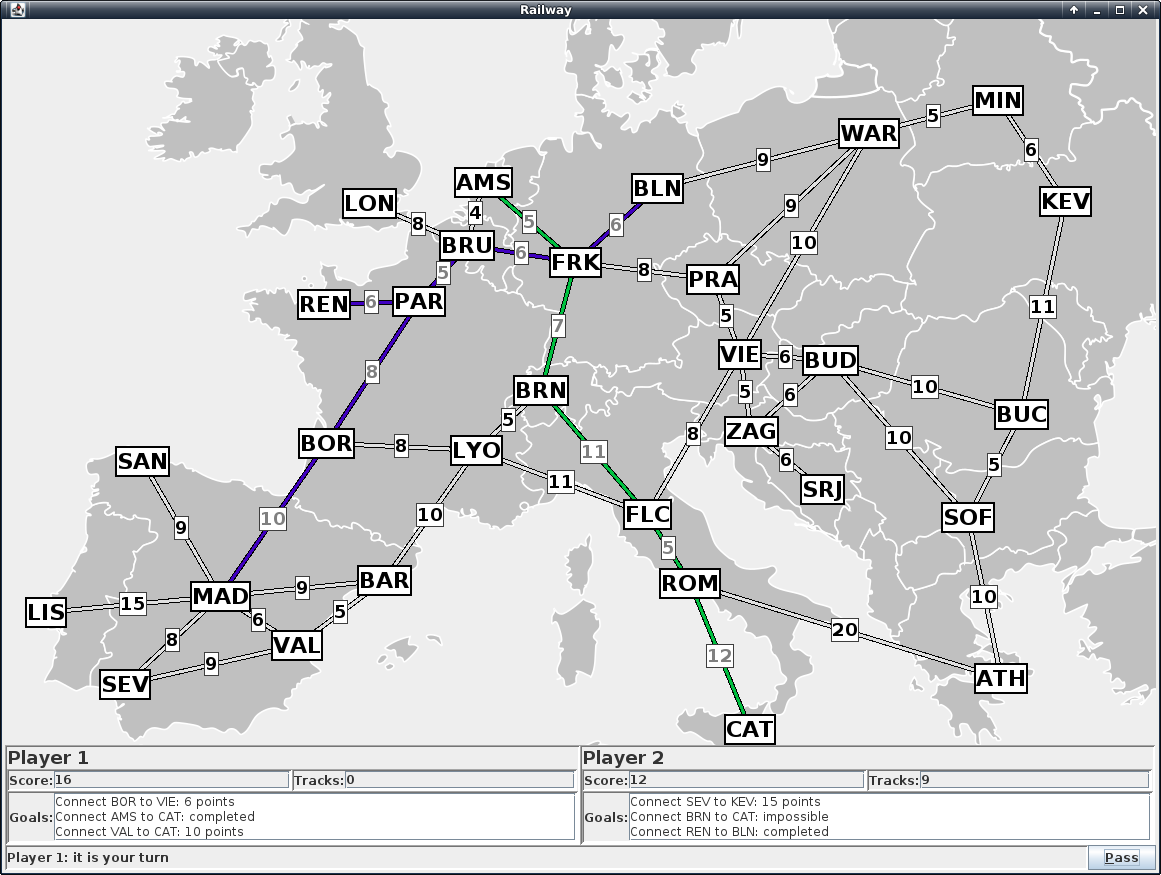CS35 Lab 09: Railway
The main goals for this lab are to understand graphs and graph algorithms, and to gain experience with more open-ended development. To that end, you will:
- Implement an undirected graph using adjacency lists.
- Implement three graph algorihms using your graph classes.
- Design an implementation of a simple train game called Railway.
- Carry out your design by implementing the Railway game.
Note: This lab is a 1.5 week assignment due the last day of the semester (Friday April 28).
As with most assignments this semester, you will be working with a partner. Both partners should be present and working on the code together. You will both be responsible for understanding all concepts, so dividing and conquering is not an option. The academic integrity policy applies to the entire pair; you cannot work or share code with anyone outside your partner.
You and your lab partner will share the same git repository,
which is named
$ git clone git@github.swarthmore.edu:CS35-s17/lab09-jbrody1-adanner1.git
Railway is a two-player route-building train game designed by Zach Palmer, inspired by the board game Ticket To Ride. Two players are given a map of possible train routes and take turns laying tracks between them. Players attempt to complete route goals while trying to connect as many cities as possible.
The GUI (graphical user interface) of Railway has been provided for you. When you launch the GUI, it will display something like:

Railway Game Rules
Setup. Railway is played on a map represented by a graph.The vertices of the graph are cities; the edges on the graph are potential railway routes. Routes have a cost in “tracks”, the resource used to build railway routes. Routes may also have an owner but, at the start of the game, neither player owns any route. Players take turns acquiring routes in order to complete goals while simultaneously connecting as many cities as possible.
Each player has a number of “tracks”, the resource used to build railway routes. Routes cost varying numbers of tracks to build. Player 1 starts with 35 tracks. Player 2 starts with 50 tracks (to compensate for the disadvantage of making the second move).
Each player also starts with three randomly-chosen goals. Each goal instructs the player to connect two cities on the map; these cities are always at least three routes apart.
Playing the game. Players alternate taking turns. Each turn, a player must do one of the following two actions:
- Claim a route. A player claims a route by selecting
that edge on the game map. In order to claim a route, the
following requirements must be met:
- The route must be unowned.
- All routes owned by a player must be connected.
- The player must pay a number of tracks equal to the route's cost.
- Pass. A player passes by clicking on the pass button. When a player passes, she gains one track for each city connected by her rail network.
Scoring. The winner of the game is the player with the highest score. A player receives one point for each connected city. The value of each goal equals the length of the shortest path between the two cities, dividing by four, and rounding down.
Example. Consider the following image of a game in
progress:

Observe the following:
- Player 1 (green) is out of tracks and must pass. This will give player 1 six more tracks (one each for (AMS, FRK, BRN, FLC, ROM, and CAT).
- Player 2 (purple) could acquire the route from MAD to SEV next turn (8 tracks) but cannot afford the route from MAD to LIS.
- Player 2 cannot acquire the route from WAR to MIN next turn, since that route is not next to a city that Player 2 has already connected.
- Player 1 has completed the goal “AMS to CAT” using the cheapest possible path (in terms of edge weight). This is worth ⌊5+7+11+5+124⌋=10 points. Player 1 has also connected six cities, for a total score of 16 points.
- Player 2 cannot complete the goal “BRN to CAT” because Player 1 owns the only route that connects CAT to the rest of the map.
The Graph Classes
As usual, theThe
Graph Algorithms
As part of this lab, you will write implementations of the following graph algorithms:- Breadth-First Search (BFS)
- Depth-First Search (DFS)
- Dijkstra's Algorithm.
Railway Code
The RailwayGUI class (The RailwayGame class (
The starting code
for
By the time you are finished, you should have a game that implements the rules of Railway as described above. To earn full credit, your program should function (no crashes or freezes) and play the game correctly (e.g. don't let players take multiple turns in a row, score the goals correctly, etc.) Your UI must also provide the following features:
- If a goal has not yet completed but is still possible, you must show its value
- You must indicate when a goal has been completed or when a goal is now impossible to complete
- If a player makes an incorrect move, you must use the message bar at the bottom of the GUI to explain the problem. (e.g. Player 1: that route has already been taken)
Running the Game
Part of the main function (the part that reads graph data from a file and creates the GUI) has already been written for you. You can run your code by runnint make and then
$ ./railway test_data/Europe_graphData.txt test_data/Europe_vertexPositions.txt test_data/Europe_background.png
The game can take diffent graphs than Europe. We've included another map for a mystical land called Testaria, the mystiacal mythical island of tests. Use this map with the command:
$ ./railway test_data/Testaria_graphData.txt test_data/Testaria_vertexPositions.txt test_data/Testaria_background.png
- Workout how you're going to solve this problem before you write any code!. It may help for you to write your plan down or discuss it before you start implementation. Make a list of the information you need to maintain (e.g. player scores, graph,...) and where you plan on keeping it (e.g. the graph class can be a data member of RailwayGame) Do not start coding before you have a design plan
- You may wish to create a Player class. If you
do, either add its declaration and definition alongside
the RailwayGame class, or create new
files
player.h, player.cpp . If you choose to create new files, make sure to addplayer.o to the OFILES variable in the Makefile, or you will get some compilation errors. - When writing Dijkstra's algorithm, you will need a minimum priority queue. The priority queue implementation you've seen this semester has been a maximum priority queue. One way to get a minimum-priority queue is to use a maximum-priority queue and invert the priorities. For example, if you have elements with priorities 6, 10, 15, then add them with priorities -6, -10, and -15. That way, when you call removeMax, you'll get the "maximum" priority of -6.
- You can select a random number using the rand
function from
stdlib.h . For instance, rand()%10 will give you a random number between 0 and 9. You will need randomness when picking goals at the start of the game.
We strongly recommend getting the graph and graph algorithms implemented and tested before coding the Railway Game. However, it might be helpful to work on the game design while or even before you implement the graph class and algorithms.
Your program is required to run without memory errors; run valgrind to eliminate them. For this lab, memory leaks are not a priority. Small memory leaks are acceptable and will not significantly affect your grade. While "lost" memory should not occur in large amounts (e.g. millions of bytes), we encourage you to not spend hours and hours tracking down every last memory leak.
Please review the CS35 Coding Style for good C++ style.
When you have completed your lab, you should have
- A working undirected graph implementation using adjacency lists.
- Implementations of BFS, DFS, and Dijkstra's algorithm.
- A working Railway game!
- No memory errors
- Code which conforms to the style guide above.
- A completed survey in README.md
Once you are satisfied with your code, hand it in using git. Remember the add, commit, push development cycle. You can push as many times as you like, but only the most recent submission will be graded. You may want to run git status to confirm all modifications have been pushed.